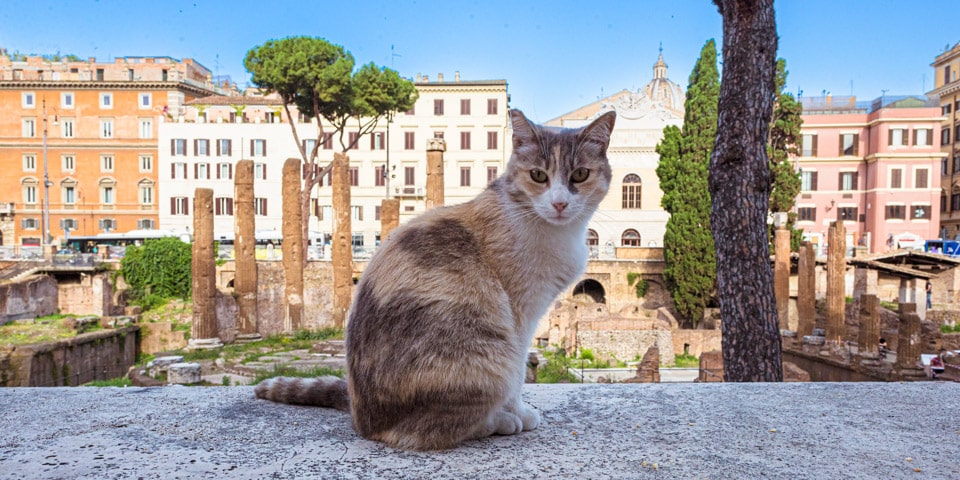

24786 views
Written by: Artur Jakucewicz

| Opening Hours |
Sunday:
-
Monday:
-
Tuesday:
-
Wednesday:
-
Thursday:
-
Friday:
-
Saturday:
-
|
|---|---|
| Recommended tour | |
| Closest bus stops |
|
| Closest subway stations |
|
| Address | Via di Torre Argentina, Roma |
| Website | www.gattidiroma.net |
Largo di Torre Argentina is one of the ancient Roman sites with a famous cat sanctuary in Rome. Moreover, this is the place where Julius Caesar was killed.
More than 200 cats live in a shelter, where you can adopt one of them at a distance and walk among the ruins.
Contents
ToggleThe Theatre of Pompey, located in the heart of Rome near the Largo di Torre Argentina square, was an architectural masterpiece and the first permanent theatre in Rome. Built in 55 BC by the Roman general Gnaeus Pompeius Magnus, the theatre could accommodate up to 20,000 spectators and hosted a variety of entertainment, including plays, orations, and gladiatorial games. Its monumental scale and intricate decorations showcased the grandeur of Roman engineering and artistic prowess.
Adjacent to the Theatre of Pompey stood the Curia of Pompey, a meeting hall that functioned as an extension of the theatre complex. The Curia was a significant political venue where senators convened for various meetings and discussions. It is particularly famous as the site of Julius Caesar’s assassination in 44 BC, a pivotal event in Roman history that marked the end of the Roman Republic and the beginning of the Roman Empire.
Largo di Torre Argentina square, situated close to the Theatre of Pompey and the Curia, is an archaeological treasure trove, comprising four ancient Republican Roman temples and the remains of Pompey’s Theatre. The temples, dating back to the 4th century BC, are known as Temples A, B, C, and D, and showcase the architectural diversity and religious significance of the area.
Today, Largo di Torre, Argentina serves as an archaeological site that showcases the rich history of Rome and as a sanctuary for the city’s stray cats, highlighting the unique interplay between ancient history and modern urban life. Visitors to the site can appreciate the architectural remnants of the Theatre of Pompey, Curia, and the four temples while also experiencing a sense of the city’s contemporary charm.
Largo di Torre Argentina was excavated during Mussolini’s rebuilding attempts in 1929 and consisted of four Republican victory temples located 20 feet below street level. Moreover, there is also part of the portico of Pompey, upon whose steps Julius Caesar was killed in 44 BCE.
In 1993, Silvia Viviani and Lia Dequel founded the Torre Argentina Cat Sanctuary (in Italian, Colonia Felinia Torre Argentina, or “Torre Argentina Feline Colony”).
Today, volunteers at Largo di Torre Atgentina care for about 250 cats at the cat sanctuary.
After the site’s excavation, cats started moving to these ruins, and locals fed them. Despite the city being full of cats, Torre Argentina is a trendy place for them.
Torre Argentina has numerous bus stops and located between Jewish Ghetto, Campo de’ Fiori, and the Pantheon areas
The organization’s cat sanctuary takes care of sick cats and has an extensive spray and neuter program to keep the feral population under control. Moreover, most of the cats in Torre Argentina, have special needs. Here, some are missing legs, handicapped, or just came from abusive homes. Many tourists and locals gather near the site to admire pets walking among the ruins.
The controversial move by archaeological authorities in recent years is to close the cat sanctuary because of the large animal population that affects the dignity and conversation of the ancient holy sites. However, many petitions favor the sanctuary; luckily, it still works, so the historic cats of the Eternal City can keep their home.
Read also about Romeow Cat Bistrot.
The cat sanctuary is open every day from 12 a.m. to 6 p.m. Official website: www.gattidiroma.net
Entrance at Largo di Torre Argentina, corner of Via Florida & Via di Torre Argentina. Visitors are always welcome to visit the cat shop or adopt one of the cats at a distance.
Also another Roman cat sanctuary is at the Protestant Cemetery near the Pyramid of Cestius.
Hotel Torre Argentina Relais is located in Largo Argentina, and offers beautiful spacious rooms with all the amenities needed to improve your Roman holiday. There is a bar, restaurant, room massage reservation, transfer upon request, and many other services. Moreover, its location will allow you to reach all the city’s main historic sites within walking distance. Prices start from 150 euros per night for 2 people.
Largo di Torre Argentina is one of the most popular sites in Rome. Every day, you can notice tourists and locals standing there and admiring cats who live among ruins. The place is magnificent and has a rich history, so it is worth visiting.
Author: Artur Jakucewicz
This website uses cookies. For more info read the cookies policy
Rome.us © 2025. Created with love by Roman experts and guides.